Finding small ways to cope with stress builds resilience
National Stress Awareness Month is the perfect time to discover healthy ways to deal with challenging situations.
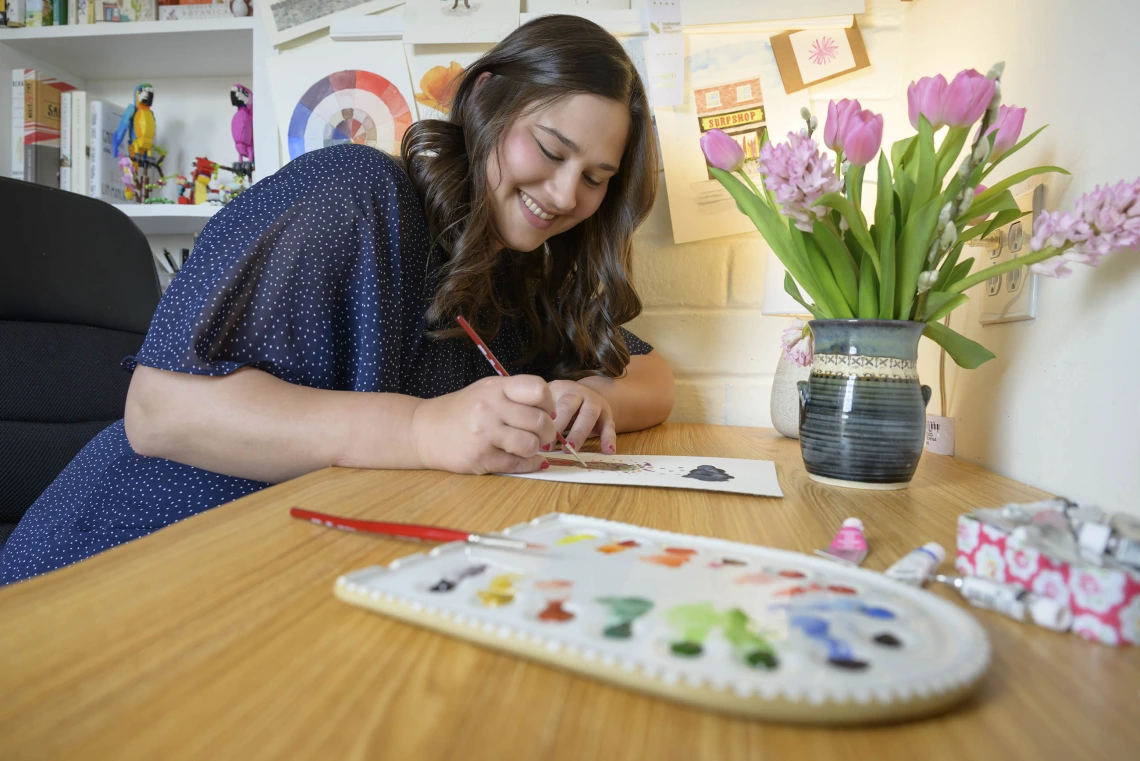
Art projects used to make Anna Alkozei, PhD, anxious, but now she finds watercolor painting a great stress reliever.
Anna Alkozei, PhD, hated art class.
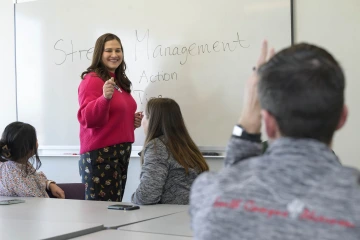
Anna Alkozei makes a point of teaching medical residents about stress management along with the practice of self-compassion.
It stressed her out, especially when she compared her work with what other kids in middle school did. Even as an adult, the feeling remained. During her clinical psychology graduate training, Alkozei dreaded drawing with the children she treated.
“I would always be really nervous about having to draw,” said Alkozei, an assistant clinical professor in the University of Arizona College of Medicine – Tucson’s Department of Family and Community Medicine. “I always had this fixed belief that you either have a talent for art or you don’t. And I always thought I just don’t have it.”
While Alkozei, a licensed clinical psychologist, gathered pens and paper for the youngsters she worked with, she set aside coloring book pages for herself. Then she realized that while she was trying to teach her young patients to have a growth mindset – the idea that students understand their abilities can be developed – she wasn’t practicing what she preached. So, she headed to Target, grabbed a kids’ watercolor set and cheap paper and fired up a YouTube video.
From worrying to winning
Five years after that first painting (a eucalyptus branch, by the way), Alkozei is a two-time award winner in the annual On Our Own Time art exhibit and competition, which is part of the National Arts Program that showcases the work of UArizona employees, their immediate families, retirees and volunteers.
More than that, Alkozei now considers watercolor painting one of her favorite stress relievers.
“We hold a lot of stress in the body and releasing that in some way, whether it's yoga or going for a walk or a run – which are things I like to do – or just trying to connect with other people to remind us we’re not alone, can help,” said Alkozei.
Handling stress mindfully
April is National Stress Awareness Month, something Alkozei knows quite a bit about. She said she was an anxious kid growing up and she lectures medical residents on behavioral health topics such as anxiety and depression, along with teaching them stress management and emotional regulation.
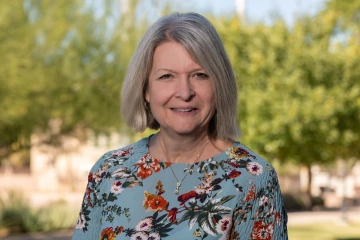
Betty Parisek, Ed.D, MSN, RN, recommends that people practice quick, mindfulness activities such as breathing exercises on a daily basis.
Working in health care is challenging and stressful, so teaching self-care for both patient and practitioner is important, said Betty Parisek, Ed.D, MSN, RN, director of the UArizona College of Nursing’s Bachelor of Science in Nursing-Integrative Health pathway.
“Our goal is to build resilience,” said Parisek, adding that the integrative health program requires nursing students’ clinical hours to include self-care for themselves.
She’s a big believer in small mindfulness exercises, whether it’s pausing to be grateful about one thing in your life, taking a quick break to go outside to be surrounded by nature or practicing breathing exercises.
“Anybody can use these techniques. It doesn't cost one single thing,” said Parisek, who turns to prayer in difficult situations. “I'm convinced if we all did it – if we all did something mindful for just five minutes a day – that the world would be a better place, that there would be more kindness. It doesn't take much to be grateful for one thing or to find hope in one thing.”
Finding what works
Relieving stress is important and unique to each individual. Different things work for different people.
“Stress relief is essential for us all and requires a diverse toolkit of easy-to-use strategies that you enjoy,” said Stephen Dahmer, MD, director of the UArizona Andrew Weil Center for Integrative Medicine. “One of my go-tos is capoeira – a blend of dance, martial arts, strength training, flexibility, music and more. I can feel with every class immediate relief from built-up stress.”
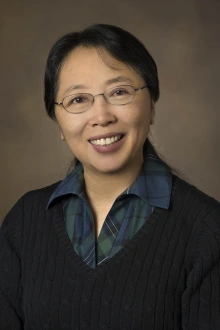
Zhao Chen, PhD, MPH, turns to singing or tai chi to relieve stress.
Noshene Ranjbar, MD, a clinical associate professor of psychiatry and the director of the integrative psychiatry program at the College of Medicine – Tucson, said she looks to the past when the present gets challenging.
“An important antidote to stress comes from remembering and reconnecting with our own sense of rootedness, authenticity and embodied belonging,” she said. “As our Indigenous relatives have taught and continue to remind me, I’ve learned to take time each day to feel my feet, preferably bare, on the Earth. In feeling the physical sensations of my feet and the resonance with the rest of my body and being, I remember that my ancestral Persian roots go back thousands of years.
“Sometimes I envision this like a tree standing strong and reaching wide, strengthened by roots running deep into the Earth. Connecting with my rich culture, ancestry, music, art, movement/dance and traditions has been essential in regaining my sense of wholeness, belonging, rootedness and resilience.”
Not all stress is bad, though. There is such a thing as eustress, said Zhao Chen, PhD, MPH, associate dean for research at UArizona’s Mel and Enid Zuckerman College of Public Health.
“Eustress is the good type of stress that you may experience on the first day of a new job or before a competition,” said Chen, who, when faced with the bad kind of stress, or distress, sings or does tai chi. “Eustress helps us concentrate and perform better and gives meaning and purpose to our lives. Finding ways to turn distress into eustress is an active area of research that has important public health implications.”
Practicing self-compassion
Alkozei teaches medical residents self-compassion as pioneered by psychologist Kristin Neff. It’s a three-pronged approach to treating oneself with kindness rather than criticism during difficult situations. Think of it as finding your inner Ted Lasso, Alkozei said, referring to the fictional soccer coach known for his good-natured optimism and compassion.

Stephen Dahmer, MD, says for him, capoeira melts away stress.
The first step in the process is mindfulness, acknowledging one’s feelings without underplaying or exaggerating, merely acknowledging without judgment.
“It’s about finding a mindful way of saying how you’re feeling, like ‘This is a moment of struggle’ or ‘I feel anxious,’” Alkozei said.
The second step is to know that being human means to experience difficult emotions.
“It’s this idea of common humanity. That we, as humans, all struggle in our lives,” Alkozei said.
Finally, the last step is self-kindness and treating yourself as you would treat a friend. Create an inner monologue that matches that approach.
“So, it's kind of asking yourself, ‘OK, what do I need to hear right now?’ ’What would I say to a good friend in this situation?’” Alkozei said.
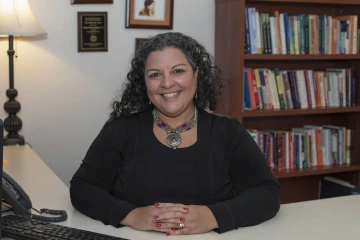
Noshene Ranjbar, MD, enjoys grounding, the practice of making contact with the Earth.
Research shows higher levels of self-compassion correspond with higher levels of happiness and connectedness. Self-compassionate people are less prone to anxiety, depression and fear of failure and are better able to admit mistakes, fix unproductive behaviors and tackle new challenges.
Alkozei is an advocate for quick self-compassion breaks such as the compassionate friend meditation. This is when you picture yourself in a favorite place and someone – a friend, a spiritual figure, a fictional character or a mentor – comes to tell you what you need to hear.
Alkozei said knowing about self-compassion when she was a kid would have really benefitted her. She teaches it to youths as part of her therapy practice.
In fact, she hopes one day to write and illustrate a children’s book on the topic. Alkozei, who often totes paints and brushes on hikes, has branched out to painting landscapes and vibrant flowers, though her usual style leans toward whimsical watercolors that feature cats. Alkozei, who has a kitty named Lily, said cats are her favorite animal.
Though she’s still roughing out the concept for her children’s book, Alkozei knows one thing for sure: “My central character is going to be a cat,” she said with a laugh. “I haven’t gotten much further than that.”

